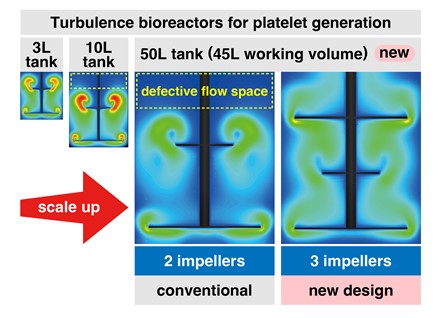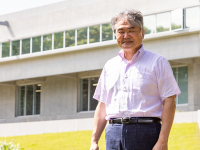Researchers developed a new 50 L bioreactor design that could improve platelet production from iPS cells in smaller tests.
In a recent effort to scale up the manufacturing of platelets using iPS cell-derived megakaryocytes, Professor Koji Eto from the Graduate School of Medicine, Chiba University and also Kyoto University, and his team of researchers through computational simulation and biological testing, conceived new design changes for an impeller-based bioreactor for large-scale, high-quality platelet production.

Image title: Turbulence Bioreactors for Platelet Generation
Image caption: Representative results of turbulent energy and shear stress for VerMES3, VerMES10, and VerMES50. There exists a defective flow space in the area surrounded by yellow dotted lines.
Image credit: Center for iPS Cell Research and Application, Kyoto University
Image license: Original content
Restriction: You are free to share and adapt the material. Attribution to the author is required.
iPS cell-derived expandable immortalized megakaryocyte progenitor cell lines (imMKCLs) represent a renewable means to produce large amounts of platelets ex vivo for transfusion. Despite generating 100 billion (1011) competent iPS cell-derived platelets using a 10-L tank system previously by recreating turbulent flow with optimal turbulent energy and shear stress, true industrial-scale manufacturing is necessary for a consistent supply of transfusable platelets for patients with thrombocytopenia and other platelet disorders. As such, the team began this study by developing a 50 L good manufacturing practices (GMP) grade, single-use United States Pharmacopoeia standard (USP) class IV polyethylene tank and a new motor regulator for competent platelet production at even larger scales.
Through computation simulation of the turbulent energy and shear stress created in such 50 L tanks by computational fluidic dynamic (CFD) analysis, the researchers determined the optimal motion speed for the larger system to mimic conditions inside the smaller tanks examined previously. Notably, the larger tank consistently showed lower efficiencies than the smaller tanks tested (3 or 10 L) even though speed was optimized to generate similar turbulent energy and shear stress as an average value. Furthermore, not only were platelets produced by the higher capacity 50 L tank lower in quantity, but they were also qualitatively poorer and showed ultrastructural abnormalities upon examination by transmission electron microscopy. Ultimately, they showed lower performance when the research team assessed their functions using in vitro assays or in vivo (hemostatic and circulatory kinetics) after transfusion into mice.
To gain biological insights into the failure to produce high-quality platelets after scaling up, the research team collected imMKCLs on days 3 and 5 of platelet production under different motion speeds and analyzed them by RNA sequencing. Principal component analysis revealed that the culturing conditions substantially altered imMKCL gene expression profiles. Whereas imMKCLs under optimal conditions (corresponding to smaller tank cultures) upregulated genes related to angiogenesis, cell adhesion, cytoskeleton, hypoxia, platelet function, and TGF-β signaling, imMKCLs under excess speed, in contrast, upregulated genes associated with inflammation and damaged mitochondria function, consistent with the production of less healthy platelets.
Finally, since it became clear that scaled-up platelet production conditions were not ideal, the research team returned to the drawing board and performed additional CFD simulations to determine whether turbulent flow became nonoptimal after scaling up. Notably, they discovered through this analysis that there is a substantial space with nonoptimized turbulent flow within the larger 50 L tank. To minimize this undesired space (non-turbulence volume), the research team simulated a three-level impeller system and found that it should reduce the volume with defective turbulent flow. However, such a system is currently not commercially available, and hence, the researchers developed a new bioreactor system to ensure a more uniform distribution of cells and turbulent flow. A small 3 L system was constructed, which showed highly efficient production of high-quality platelets as expected.
Although additional work is needed to build a larger scale system and test the new bioreactor design, the research team expects the scaling-up process to go smoother next time because the new design does not share the same limitations.
Reference:
Title of original paper: Defective flow space limits the scaling up of turbulence bioreactors for platelet generation
Authors: Haruki Okamoto1,#, Kosuke Fujio1,2,#, Sou Nakamura1,#, Yasuo Harada1,2, Hideki Hayashi2, Natsumi Higashi1, Atsushi Ninomiya1, Ryota Tanaka1, Naoshi Sugimoto1, Naoya Takayama3, Atsushi Kaneda3, Akira Sawaguchi4, Yoshikazu Kato5, Koji Eto1,3,*
#: Equally contributed to this study *: Corresponding author
Affiliations:
- Department of Clinical Application, Center for iPS Cell Research and Application (CiRA), Kyoto University
- Otsuka Pharmaceutical Company Limited, Department of Drug Modality Development, Osaka Research Center for Drug Discovery
- Graduate School of Medicine, Chiba University
- Department of Anatomy, Faculty of Medicine, University of Miyazaki
- Mixing Technology Laboratory, SATAKE MultiMix Corporation
Journal: Communications Engineering
DOI: 10.1038/s44172-024-00219-y
Contact:
Koji Eto
Graduate School of Medicine, Chiba University & Center for iPS Cell Research and Application (CiRA),
Kyoto University
Email: eto.koji.8a@kyoto-u.ac.jp
Public Relations Office, Chiba University
Address: 1-33 Yayoi, Inage, Chiba 263-8522 JAPAN
Email: koho-press@chiba-u.jp
Tel: +81-43-290-2018
International Public Communications Office,
Center for iPS Cell Research and Application (CiRA),
Kyoto University
Address: 53 Kawahara-cho, Shogoin, Sakyo-ku, Kyoto 606-8507 JAPAN
Email: media@cira.kyoto-u.ac.jp
Tel: +81-75-366-7005
Recommend
-

The reciprocity of life: The interactive relationships between people, plants, and the environment
2023.05.19
-

Cracking Error with Math: Error Correction in Classical and Quantum Computers
2024.09.02
-

Nurturing Teaching Personnel for Multicultural Societies: High Schools-Universities-Graduate Schools’ Tripartite Collaboration to Develop Educational Programs in ASEAN Countries
2023.08.25


